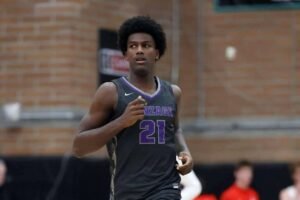
The Dual-Sport Dream
For athletes like Michigan-bound quarterback Carter Smith and Oregon’s wide receiver commit Jalen Reeves, choosing between football and basketball has never been a binary decision. Despite being rated as four-star football recruits with clear paths to college stardom and potential NFL futures, both young men continue to chase basketball opportunities — not as a hobby, but as serious athletic pursuits.
“I’ve been hooping since I could walk,” says Reeves, a 6-foot-4 explosive athlete whose vertical leap dazzles just as much in basketball as it does in his go-route patterns. “Football came later, but I never stopped loving basketball. Even now, I make sure I’m in the gym shooting at least three times a week, even during football season.”
College Coaches Embracing Versatility
In the past, high-level college football coaches were skeptical of athletes splitting time, worried that dual-sport participation might lead to fatigue, injury, or less commitment. But today’s top-tier coaches — particularly at Michigan and Oregon — are embracing the idea that multi-sport athletes often arrive with a sharper competitive edge, better footwork, and heightened spatial awareness.
Michigan head coach Sherrone Moore, who took over the Wolverines’ reins after Jim Harbaugh’s departure, has been vocal about his admiration for multi-sport athletes. “Basketball teaches balance, hand-eye coordination, and decision-making in tight spaces — all things that translate beautifully to football. If a kid can play both and wants to, I say go for it.”
Oregon’s Dan Lanning echoes that sentiment. “We’re not here to limit our guys. We’re here to develop them into the best versions of themselves. If that means playing both sports for a while, we’ll support them.”
The Challenge of Time and Commitment
Still, the balancing act is no easy feat. Offseason football workouts often overlap with basketball practices. Spring football collides with AAU basketball, and both sports demand year-round physical conditioning. The recruits must constantly manage expectations, calendars, and bodies.
“I’ve had to make sacrifices,” Carter Smith admits. “There are weekends I’m playing a tournament and still watching film late at night to prepare for 7-on-7 the next morning. It’s draining, but it’s what I love.”
Long-Term Decisions Loom
Eventually, most of these athletes will have to choose. The grind of D-I football, especially at schools competing for College Football Playoff spots, leaves little room for side endeavors. Yet some still hold out hope.
Reeves remains open to the possibility of walking on to Oregon’s basketball team. “If the opportunity presents itself and my body holds up, I’d love to give it a shot.”
Smith, meanwhile, is taking a more pragmatic approach. “Football is where my scholarship is. It’s my priority. But I’ll always carry that basketball fire with me — even if it’s just in pickup games down the line.”
Conclusion: More Than Just Football Players
For Michigan and Oregon’s latest recruits, the journey isn’t just about becoming the next NFL draft pick. It’s about honoring every part of their athletic identities. These players are not just football stars — they are competitors, multi-dimensional athletes, and young men refusing to be boxed in by the pressures of early specialization.
As fans, we often crave singular narratives: football star, basketball phenom. But for these recruits, the truth lies somewhere in between — in the crossover step, the post pattern, and the never-ending pursuit of athletic greatness, no matter the sport.

1 Comment
Sweet website , super style and design, rattling clean and apply friendly.